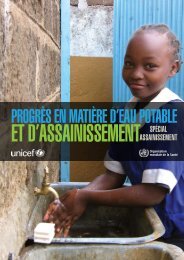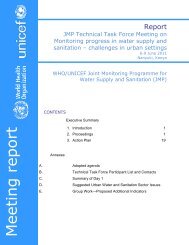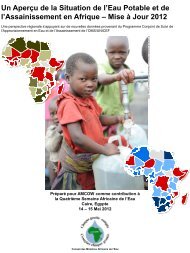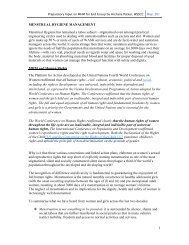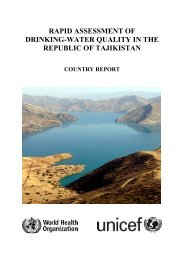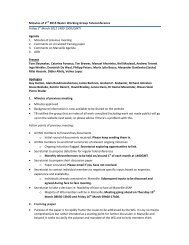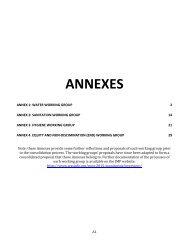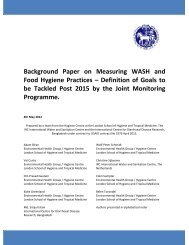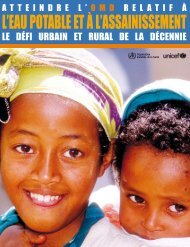Rapid assessment of drinking-water quality in the - WHO/UNICEF ...
Rapid assessment of drinking-water quality in the - WHO/UNICEF ...
Rapid assessment of drinking-water quality in the - WHO/UNICEF ...
Create successful ePaper yourself
Turn your PDF publications into a flip-book with our unique Google optimized e-Paper software.
3.3 Aes<strong>the</strong>tic parameters<br />
The three aes<strong>the</strong>tic parameters tested were conductivity, iron content and turbidity. Conductivity was<br />
used as a surrogate for <strong>the</strong> level <strong>of</strong> dissolved solids <strong>in</strong> <strong>the</strong> <strong>water</strong> supplies and hence was a measure <strong>of</strong><br />
<strong>the</strong> sal<strong>in</strong>ity <strong>of</strong> <strong>the</strong> <strong>water</strong>. For almost <strong>the</strong> entire country, conductivity was above <strong>the</strong> Jordanian<br />
permitted limit <strong>of</strong> 700 S/cm, although none <strong>of</strong> <strong>the</strong> <strong>water</strong> supplies exceeded <strong>the</strong> Jordanian maximum<br />
limit <strong>of</strong> 2100 S/cm (Table 3.6).<br />
Table 3.6<br />
Broad area<br />
Compliance <strong>of</strong> Jordanian utility piped <strong>water</strong> supplies with<br />
<strong>WHO</strong> recommendations and national standards for<br />
conductivity a<br />
Conductivity<br />
a<br />
n<br />
Satisfy<strong>in</strong>g <strong>WHO</strong><br />
suggested value <strong>of</strong><br />
1400 S/cm (%)<br />
Compliance with<br />
allowed national<br />
standard <strong>of</strong> 700<br />
S/cm (%)<br />
Compliance with<br />
maximum national<br />
standard <strong>of</strong> 2100<br />
S/cm (%)<br />
Amman 611 100.0 3.3 100.0<br />
Albalqa 146 100.0 33.6 100.0<br />
Alzarqa 244 94.7 0.4 100.0<br />
Madaba 25 100.0 0 100.0<br />
Irbed 270 100.0 15.9 100.0<br />
Almafraq 73 100.0 38.4 100.0<br />
Jarash 73 100.0 28.8 100.0<br />
Ajloun 49 100.0 18.4 100.0<br />
Alkarak 73 91.8 15.1 100.0<br />
Altafiela 25 100.0 96.0 100.0<br />
Ma’an 25 100.0 44.0 100.0<br />
Aqaba 25 100.0 56.0 100.0<br />
National 1 639 98.8 14.1 100.0<br />
n = total number <strong>of</strong> samples assessed.<br />
Water supplies <strong>in</strong> <strong>the</strong> Albalqa, Alzarqa and Ajloun governorates were contam<strong>in</strong>ated with iron, which<br />
likely was caused by rust<strong>in</strong>g pipes and <strong>in</strong>termittent <strong>water</strong> supplies (Table 3.7). Generally, Jordanian<br />
<strong>water</strong> supplies were clear: All <strong>of</strong> <strong>the</strong> samples had a turbidity <strong>of</strong> less than 5 NTU, and 99.8% <strong>of</strong> <strong>the</strong><br />
samples were <strong>in</strong> compliance with <strong>the</strong> more str<strong>in</strong>gent allowed national standard <strong>of</strong> 1 NTU (Table 3.8).<br />
19



